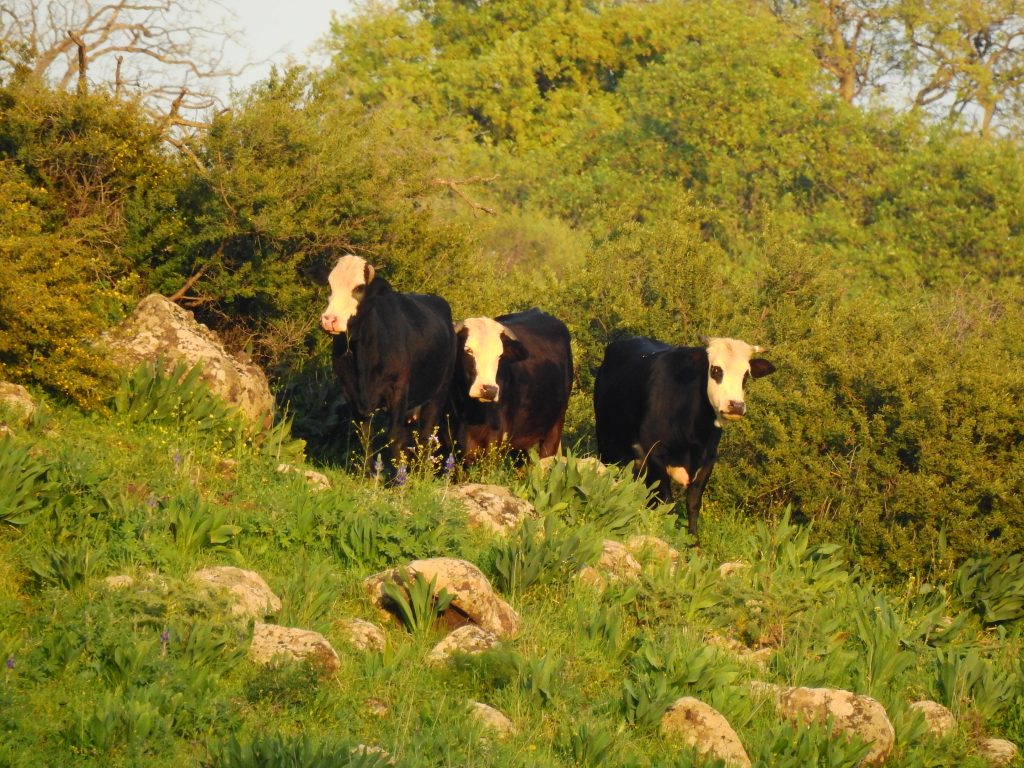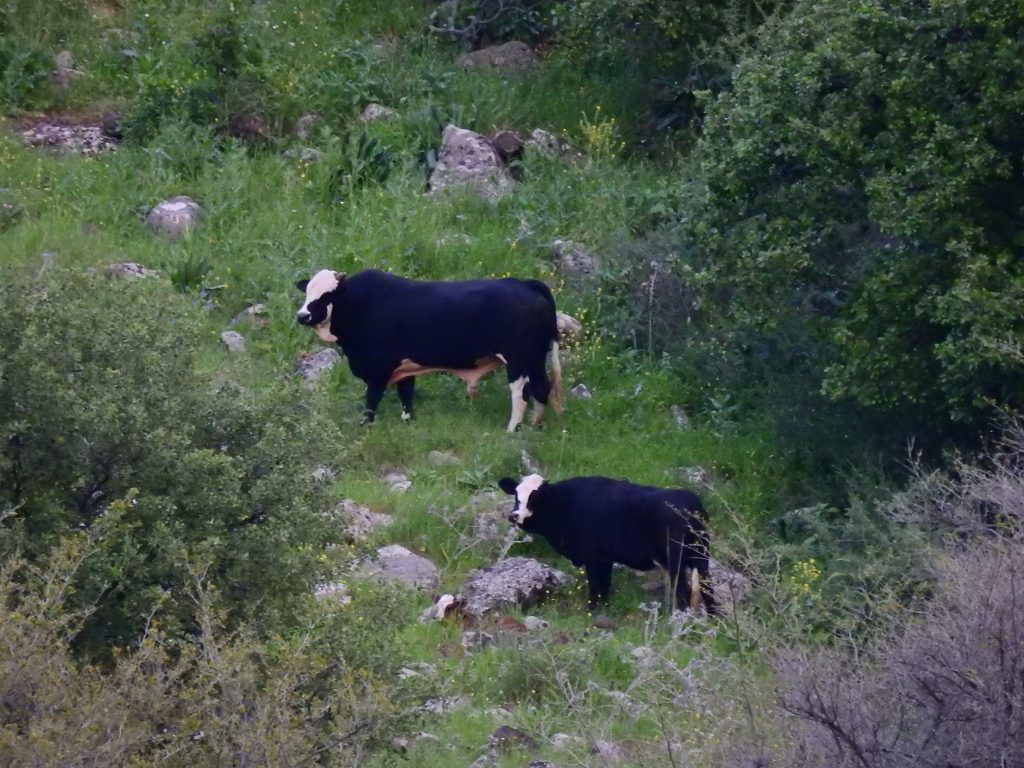The Independent Cows of the Golan Heights
May 18, 2021Since 1967, a unique herd of free-ranging cows have been thriving in the Golan Heights. After surviving wars and attempted culling, the woman who has accompanied them for years hopes they will receive official protection from the state.
Anyone who walks in the afternoon between Nahal Meshushim and Nahal Zavitan in the Golan Heights may see them—a herd of several dozen grazing cows. At first glance you might think that this is a normal herd of mature cows and their small calves, brown, black and white, peacefully walking between the rocks and bushes. But unlike other cows often encountered while hiking in the north, these cows do not belong to a farmer, or anyone for that matter. In fact, this is the only free herd of cows in Israel.
The origin of this wild herd (already nicknamed the “Syrian cattle herd”, or the “Baladi herd”) is similar to that of many of the industrial cow herds that currently exist in the Golan Heights.
These cows originally belonged to Syrian farmers, but after the Six Day War, they didn’t end up moving to Syria with them. “They instead remained in the Golan Heights forming the basis for the established Israeli cattle in the region,” says Racheli Gabrieli, Director of Beef Cattle Services for the Ministry of Agriculture.
According to her, most of these cows were collected by Israeli breeders after 1967 but not all of them. “A herd of about 150 cows remained that were not collected. Apparently, these were the more temperamental cows— the ones who were difficult to lead to the corral. They just stayed in the area, and since then, they have not been owned by people.”
Thriving in the Wilderness

“These cows are actually behaving like wildlife,” Gabrieli says. “They collect their own food in the wild, feed their calves naturally, and receive zero food supplements or veterinary treatments.”
By contrast, cows raised in the meat and dairy industry are unable to produce enough milk for feeding without the food supplements given to them by workers. This is because in recent decades, the breeds of industrial cows in Israel have undergone significant changes.
“Females have been mated with males from abroad causing Israeli breeds to gradually become more similar to European and American cows. As a result, they can produce more meat and greater amounts of milk, but they aren’t adapted to local conditions in Israel, and therefore they need a lot of supportive care. In general, production is in conflict with durability,” Gabrieli explains.
Farm cows are also required to receive vaccines against diseases and treatments for ticks to prevent tick fever, one of the main causes of morbidity and mortality for cows in Israel.
The wild cows, however, have not undergone any cultivation since 1967 and have thus remained mostly unchanged to the cows that lived in the area in those days—smaller and more adapted to local conditions.
“When we travel to third world countries, we usually can’t drink the water, but the locals can. It’s the same for local animal breeds like cows who develop resistance by gradually being exposed to pests and diseases over years and generations, and it acts like a vaccine,” says Gabrieli. “It’s a breed that is maximally adapted to the environment in which it lives.”
As part of this adjustment, the wild cows are slightly smaller than those belonging to the industrial herds. “The cows weigh a little less than 400 kilograms, while the average cow in the Israeli herd currently weighs about 550-600 kilograms,” she says. “The wild cows are also much more athletic, and they are able to escape like a missile and run down a slope like a deer.”
A Misinformed Culling

The close and compact nature of the herd also protects the wild cows from hunting threats. “In the past, there were illegal attempts to hunt them, but as the cultivation progressed, their meat lost much of its value. It is a very lean meat that has little monetary value,” says Gabrieli.
However, other factors have significantly harmed the herd over the years, and even threatened its continued existence. “In the 1990s, veterinary services feared that the herd was a source of disease, so an order was issued to eradicate them,” says Gabrieli.
“Out of 150 cows that lived in the herd at the time, 70 were shot. The killing only stopped when Dr. Doron Tiomkin, who was a veterinarian for a neighboring farm at the time created a very broad public protest.” Gabrieli went on to point out that the cows that died after being shot were later examined, and they were found to be absent of any sort of disease.
After the tragic event, the herd of cows lived quietly for almost 30 years. However, a few months ago a new threat to their existence arose. “Officials in the Nature and Parks Authority wanted to eliminate the herd because they blamed them for the pollution of the streams in the area,” says Gabrieli. “However, according to a quantitative calculation I made, the maximum possible contribution of Escherichia coli from cow excrement into nearby streams was about 4 units. The Ministry of Health, on the other hand, determines that a particular river or stream is only dangerous for human bathing if the pollution is over 400 units. It’s clear then that the contamination has another source—one that is not derived from cattle.”
“The people of the Nature and Parks Authority were not ready to hear me,” she continues. “The director general of the Ministry of Agriculture issued a letter to the Nature and Parks Authority stating that the professionals in the ministry were convinced that the herd is not the source of the pollution, but it did not convince them. In the end however, we managed to dissuade the Nature and Parks Authority from taking action against the herd with the help of Tal Gilboa, the Prime Minister’s Adviser on Animal Affairs, who established a direct dialogue with the authority.”
The Nature and Parks Authority responded by stating the herd’s close proximity to the creek channel was what prompted their concern and that alongside the Ministry of Environmental Protection, the Ministry of Agriculture, and the Water Authority, water troughs would be placed far from flow paths and fences would be installed to reduce cattle activity from occurring too close to the stream. However, they also noted, “this is not a protected animal, but a wild animal that has gone wild.”
Indigenous Durability

While the herd was originally comprised of 150 wild cows, their numbers today are much smaller as the herd only stands at about 40 individuals where close to half are females and half are males. According to Gabrieli, the reason for this is likely due to the significant culling the herd experienced in the 1990s.
“Once you kill individuals from a population, especially when it comes to a herd, which has a very delicate social fabric, it impairs the herd’s ability to recover, and that’s probably what happened to this herd,” she says. “When a population size falls below a certain threshold, its rate of reproduction decreases because its genetic diversity is smaller, so its resistance is impaired. If a new disease suddenly appears, which some cows are resistant to and some are not, too many cows will be harmed.” Gabrieli believes it is also possible that the breedings between individuals within the same family due to the small size of the population, among other things, harms the fertility of the offspring.
According to Gabrieli, it is important to keep the wild cows in the Golan for the sake of the cows that belong to farmers. “Due to the effects of the climate crisis and the expansion in the spread of disease, we will need the durable and resistant traits of the original breeds and integrate the genes responsible for their resilience into cultivation programs,” she says. “This knowledge does not exist in the world, and it should be produced here in Israel.”
Beyond that, the responsibility of Israel to preserve the wild cows is part of the country’s commitment to international conventions, particularly the UN’s Convention on Biological Diversity. The issue of local indigenous breeds is gaining great importance in the world today, and it is also reflected in such international conventions,” says Gabrieli.
“These 40 cows are not a nuisance, and they were not a nuisance even when they were at their peak size. They didn’t steal pasture from anyone, and they didn’t cause any harm to humans, the environment, or neighboring herds. There has never been a justifiable reason to harm them, and I would be very happy if the herd manages to survive for generations to come,” she concludes.
This ZAVIT Article was also published in The Jerusalem Post on 16 May 2021







